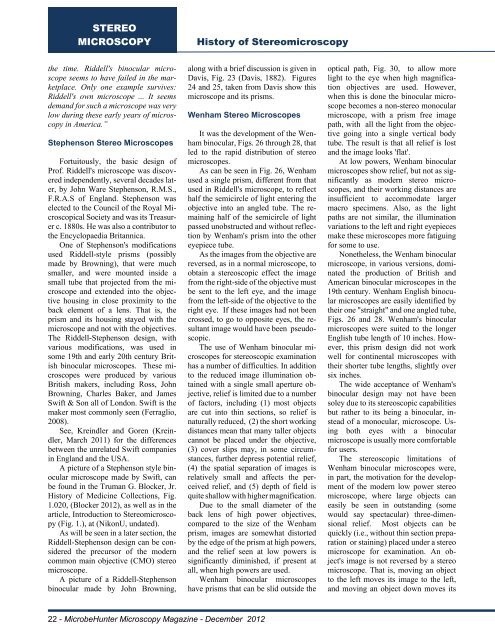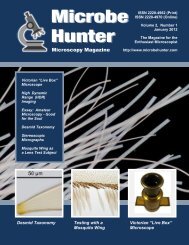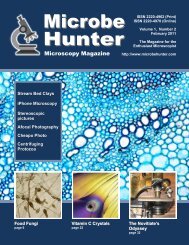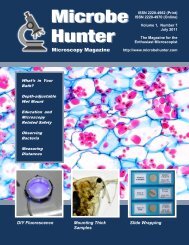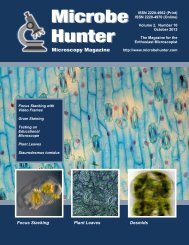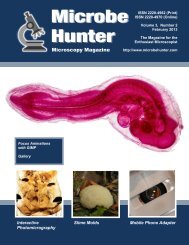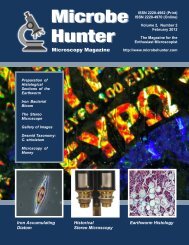December 2012 - MicrobeHunter.com
December 2012 - MicrobeHunter.com
December 2012 - MicrobeHunter.com
You also want an ePaper? Increase the reach of your titles
YUMPU automatically turns print PDFs into web optimized ePapers that Google loves.
STEREOMICROSCOPYHistory of Stereomicroscopythe time. Riddell's binocular microscopeseems to have failed in the marketplace.Only one example survives:Riddell's own microscope ... It seemsdemand for such a microscope was verylow during these early years of microscopyin America.”Stephenson Stereo MicroscopesFortuitously, the basic design ofProf. Riddell's microscope was discoveredindependently, several decades later,by John Ware Stephenson, R.M.S.,F.R.A.S of England. Stephenson waselected to the Council of the Royal MicroscopicalSociety and was its Treasurerc. 1880s. He was also a contributor tothe Encyclopaedia Britannica.One of Stephenson's modificationsused Riddell-style prisms (possiblymade by Browning), that were muchsmaller, and were mounted inside asmall tube that projected from the microscopeand extended into the objectivehousing in close proximity to theback element of a lens. That is, theprism and its housing stayed with themicroscope and not with the objectives.The Riddell-Stephenson design, withvarious modifications, was used insome 19th and early 20th century Britishbinocular microscopes. These microscopeswere produced by variousBritish makers, including Ross, JohnBrowning, Charles Baker, and JamesSwift & Son all of London. Swift is themaker most <strong>com</strong>monly seen (Ferraglio,2008).See, Kreindler and Goren (Kreindler,March 2011) for the differencesbetween the unrelated Swift <strong>com</strong>paniesin England and the USA.A picture of a Stephenson style binocularmicroscope made by Swift, canbe found in the Truman G. Blocker, Jr.History of Medicine Collections, Fig.1.020, (Blocker <strong>2012</strong>), as well as in thearticle, Introduction to Stereomicroscopy(Fig. 1.), at (NikonU, undated).As will be seen in a later section, theRiddell-Stephenson design can be consideredthe precursor of the modern<strong>com</strong>mon main objective (CMO) stereomicroscope.A picture of a Riddell-Stephensonbinocular made by John Browning,along with a brief discussion is given inDavis, Fig. 23 (Davis, 1882). Figures24 and 25, taken from Davis show thismicroscope and its prisms.Wenham Stereo MicroscopesIt was the development of the Wenhambinocular, Figs. 26 through 28, thatled to the rapid distribution of stereomicroscopes.As can be seen in Fig. 26, Wenhamused a single prism, different from thatused in Riddell's microscope, to reflecthalf the semicircle of light entering theobjective into an angled tube. The remaininghalf of the semicircle of lightpassed unobstructed and without reflectionby Wenham's prism into the othereyepiece tube.As the images from the objective arereversed, as in a normal microscope, toobtain a stereoscopic effect the imagefrom the right-side of the objective mustbe sent to the left eye, and the imagefrom the left-side of the objective to theright eye. If these images had not beencrossed, to go to opposite eyes, the resultantimage would have been pseudoscopic.The use of Wenham binocular microscopesfor stereoscopic examinationhas a number of difficulties. In additionto the reduced image illumination obtainedwith a single small aperture objective,relief is limited due to a numberof factors, including (1) most objectsare cut into thin sections, so relief isnaturally reduced, (2) the short workingdistances mean that many taller objectscannot be placed under the objective,(3) cover slips may, in some circumstances,further depress potential relief,(4) the spatial separation of images isrelatively small and affects the perceivedrelief, and (5) depth of field isquite shallow with higher magnification.Due to the small diameter of theback lens of high power objectives,<strong>com</strong>pared to the size of the Wenhamprism, images are somewhat distortedby the edge of the prism at high powers,and the relief seen at low powers issignificantly diminished, if present atall, when high powers are used.Wenham binocular microscopeshave prisms that can be slid outside theoptical path, Fig. 30, to allow morelight to the eye when high magnificationobjectives are used. However,when this is done the binocular microscopebe<strong>com</strong>es a non-stereo monocularmicroscope, with a prism free imagepath, with all the light from the objectivegoing into a single vertical bodytube. The result is that all relief is lostand the image looks 'flat'.At low powers, Wenham binocularmicroscopes show relief, but not as significantlyas modern stereo microscopes,and their working distances areinsufficient to ac<strong>com</strong>modate largermacro specimens. Also, as the lightpaths are not similar, the illuminationvariations to the left and right eyepiecesmake these microscopes more fatiguingfor some to use.Nonetheless, the Wenham binocularmicroscope, in various versions, dominatedthe production of British andAmerican binocular microscopes in the19th century. Wenham English binocularmicroscopes are easily identified bytheir one "straight" and one angled tube,Figs. 26 and 28. Wenham's binocularmicroscopes were suited to the longerEnglish tube length of 10 inches. However,this prism design did not workwell for continental microscopes withtheir shorter tube lengths, slightly oversix inches.The wide acceptance of Wenham'sbinocular design may not have beensoley due to its stereoscopic capabilitiesbut rather to its being a binocular, insteadof a monocular, microscope. Usingboth eyes with a binocularmicroscope is usually more <strong>com</strong>fortablefor users.The stereoscopic limitations ofWenham binocular microscopes were,in part, the motivation for the developmentof the modern low power stereomicroscope, where large objects caneasily be seen in outstanding (somewould say spectacular) three-dimensionalrelief. Most objects can bequickly (i.e., without thin section preparationor staining) placed under a stereomicroscope for examination. An object'simage is not reversed by a stereomicroscope. That is, moving an objectto the left moves its image to the left,and moving an object down moves its22 - <strong>MicrobeHunter</strong> Microscopy Magazine - <strong>December</strong> <strong>2012</strong>


